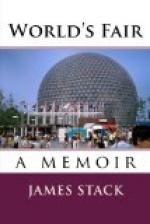More coaches, omnibusses, waggons, vans, and other conveyances, crowd the streets of London than any other city in the world. You will, perhaps, be a little surprised when I tell you that in one principal street, seven thousand vehicles pass to and fro every day. Almost every kind of manufacture is carried on in London; silk goods, jewellery, clocks, watches, ear-rings, hats, furniture, instruments of every kind, porter and ale, with many more that I cannot now remember. However, you must not think, from all this, there are no poor people in London; for, unfortunately, there are thousands. Some beg, others steal, and those who are honest and able to labour, work. But those who cannot obtain work are very badly off; and persons die from starvation.
The industrial manufactures of Scotland are like those of England; the exports are linens, muslins, woollen stuffs, cottons, iron, lead, glass, earthenware, leather, and other articles. The chief manufacture is linen: but manufactures of stoves, and grates, and many other things, from their immense iron works, particularly from those of Carron, are also a principal part of the industrial products.
[Illustration]
The Scotch people are remarkable for their thrift and prudence; the lower orders are in general well-educated, and it is the height of ambition in a Scottish mechanic, to appear with his family in neat, clean dresses, on Sundays and other holidays.
The costume of the Highlanders is very picturesque; the plaid is made of woollen stuff, of various colours, with a jacket, and a short petticoat called a kilt, which leaves the knees bare; the stockings are also a plaid, generally red and white, and do not reach up to the knees, but are tied round the legs with scarlet garters. The head-dress is a flat blue bonnet, as it is called, ornamented round with scarlet and white plaid, and frequently adorned with eagle’s feathers. The Highland women go without shoes or stockings, and wear short petticoats, a plaid jacket, and a plaid scarf.
Most of the Scotch people are intelligent, and so far advanced in education, that even the miners in the south have a library, where they read, and improve their minds; and yet these poor miners were little better than in a state of slavery two hundred years since. The favourite musical instrument, with the Scotch, is the bag-pipe; which does not, however, sound quite so well to our English ears, as it does to theirs. Their national dances are the Highland reel, and fling, which they perform with great agility and grace. The sheep and cattle are rather small, but give exceedingly good meat; and the sheep, in particular, are valued for their fleece, which is almost as fine as the best Spanish wool.
Edinburgh, the capital of Scotland, is, in the new parts of it, a fine clean city; the houses in the old town are excessively high, and the streets inconvenient; but the streets of the new town are very broad, and almost all in straight lines; some of them are a mile long. Most of the houses are built of white stone, which sparkles as if it was inlaid with diamonds when the sun shines on it.




